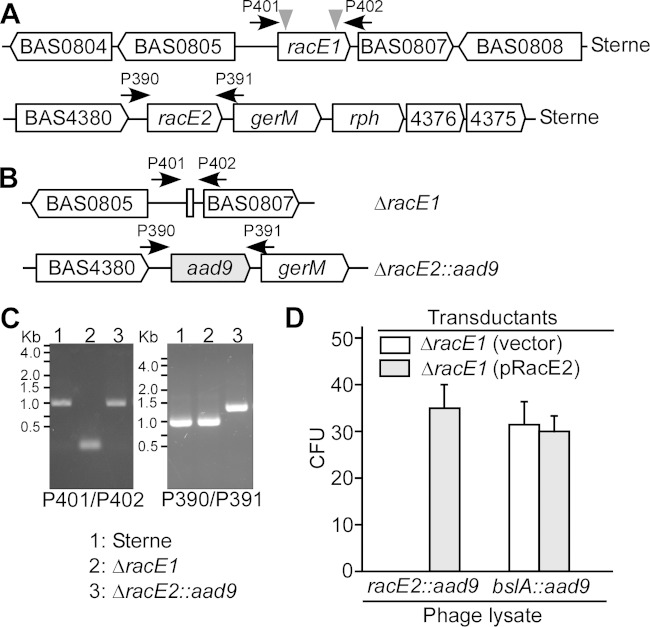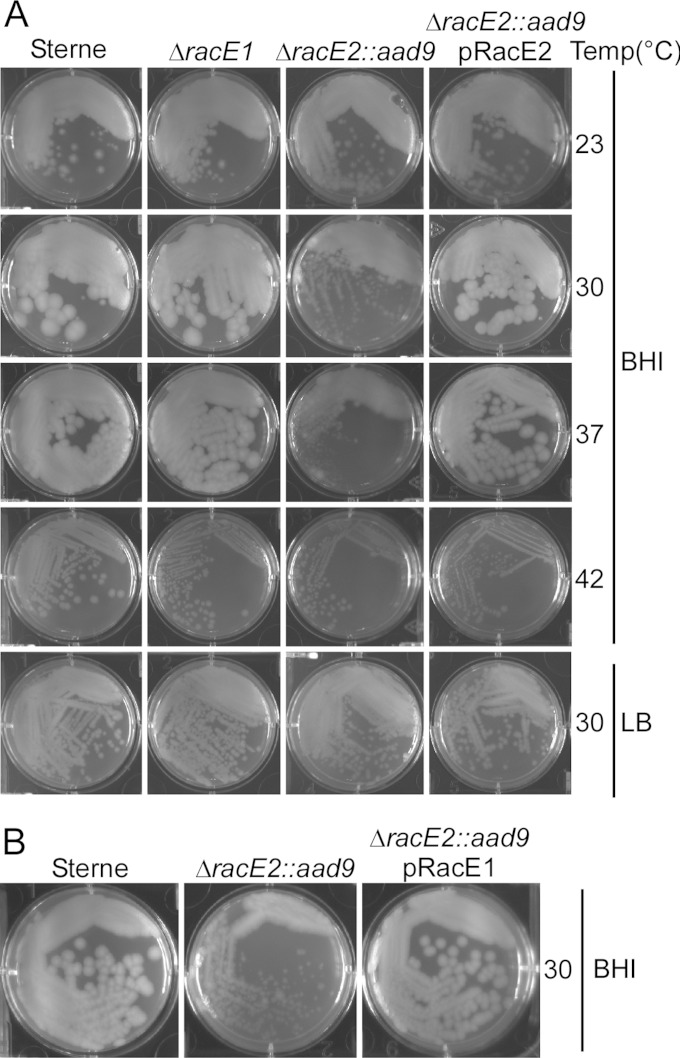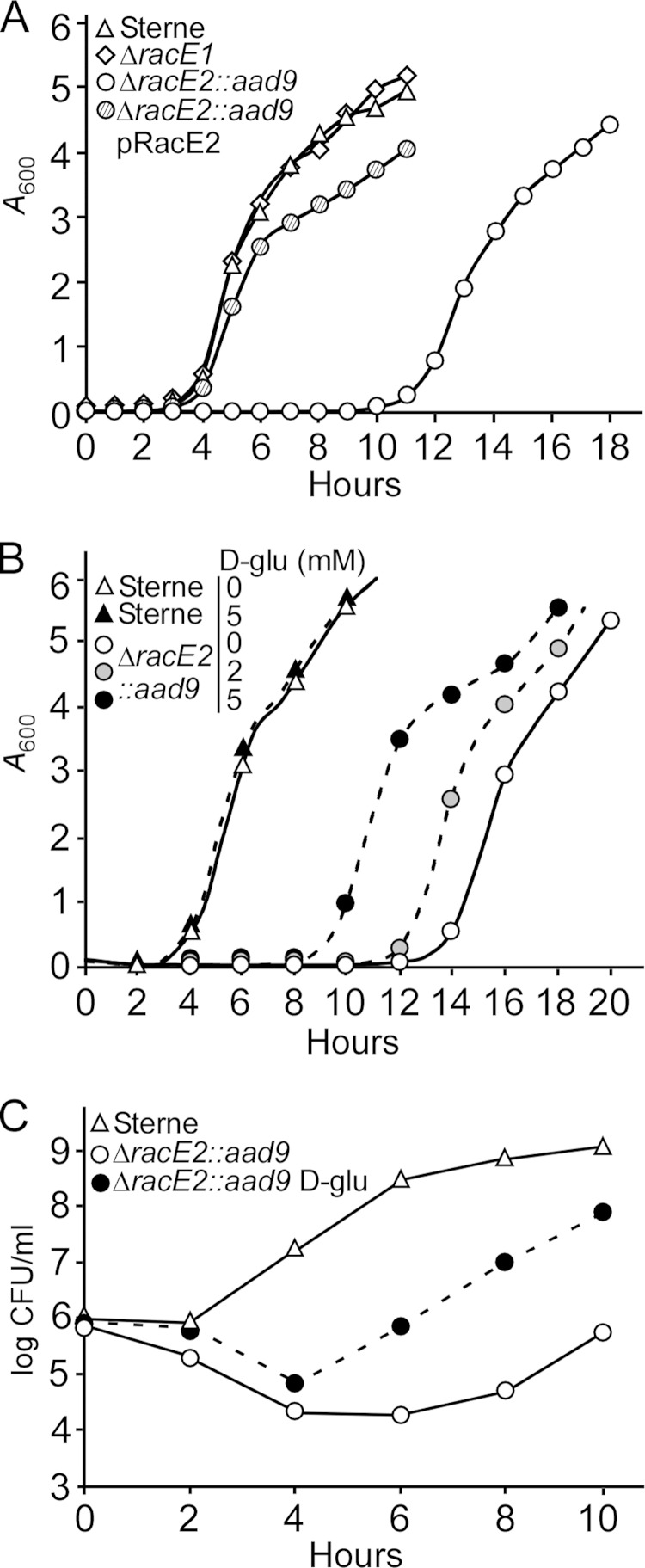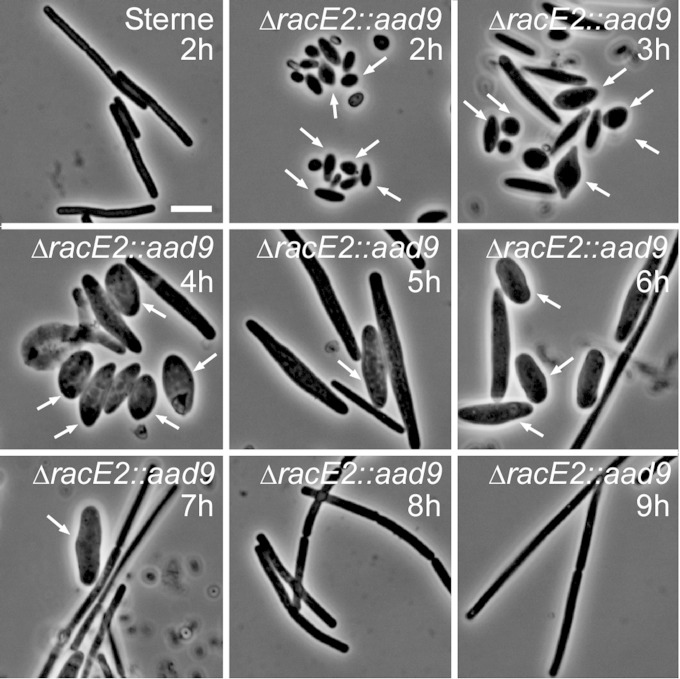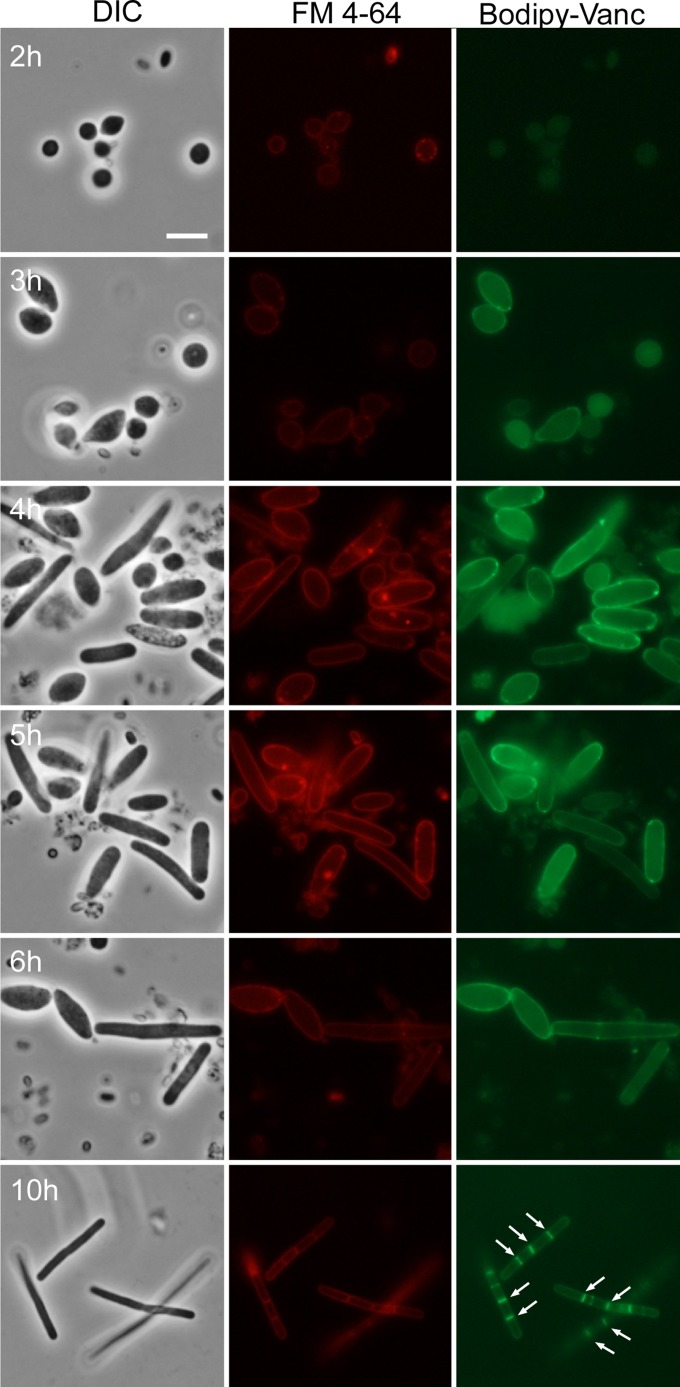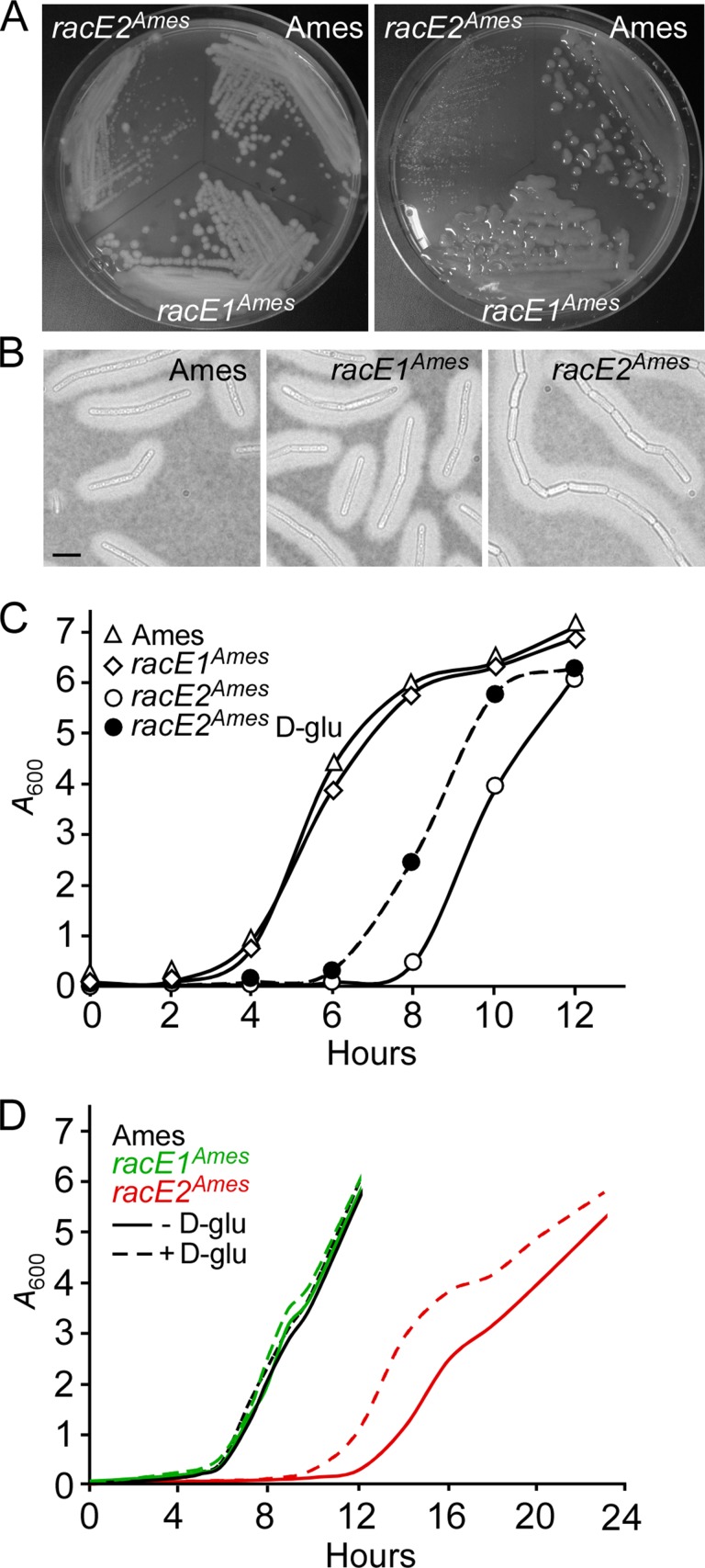ABSTRACT
d-Glutamate is an essential component of bacterial peptidoglycan and a building block of the poly-γ-d-glutamic acid (PDGA) capsule of Bacillus anthracis, the causative agent of anthrax. Earlier work suggested that two glutamate racemases, encoded by racE1 and racE2, are each essential for growth of B. anthracis, supplying d-glutamic acid for the synthesis of peptidoglycan and PDGA capsule. Earlier work could not explain, however, why two enzymes that catalyze the same reaction may be needed for bacterial growth. Here, we report that deletion of racE1 or racE2 did not prevent growth of B. anthracis Sterne (pXO1+ pXO2−), the noncapsulating vaccine strain, or of B. anthracis Ames (pXO1+ pXO2+), a fully virulent, capsulating isolate. While mutants with deletions in racE1 and racE2 were not viable, racE2 deletion delayed vegetative growth of B. anthracis following spore germination and caused aberrant cell shapes, phenotypes that were partially restored by exogenous d-glutamate. Deletion of racE1 or racE2 from B. anthracis Ames did not affect the production or stereochemical composition of the PDGA capsule. A model is presented whereby B. anthracis, similar to Bacillus subtilis, utilizes two functionally redundant racemase enzymes to synthesize d-glutamic acid for peptidoglycan synthesis.
IMPORTANCE Glutamate racemases, enzymes that convert l-glutamate to d-glutamate, are targeted for antibiotic development. Glutamate racemase inhibitors may be useful for the treatment of bacterial infections such as anthrax, where the causative agent, B. anthracis, requires d-glutamate for the synthesis of peptidoglycan and poly-γ-d-glutamic acid (PDGA) capsule. Here we show that B. anthracis possesses two glutamate racemase genes that can be deleted without abolishing either bacterial growth or PDGA synthesis. These data indicate that drug candidates must inhibit both glutamate racemases, RacE1 and RacE2, in order to block B. anthracis growth and achieve therapeutic efficacy.
INTRODUCTION
d-Glutamate is a component of peptidoglycan, a structure essential for the physical integrity and the growth of bacteria (1, 2). Earlier work sought to target bacterial d-glutamate synthesis for antibiotic development; however, broad-spectrum inhibitors of d-glutamate synthesis have not yet been reported (3–7). Two distinct enzymatic routes have been identified for bacterial d-glutamate biosynthesis. Glutamate racemase produces d-glutamate by the reversible stereoinversion of l-glutamate (4, 8). d-Amino-acid transaminase catalyzes the pyridoxal phosphate (PLP)-mediated, reversible transamination of d-alanine and α-ketoglutarate, generating d-glutamate and pyruvate (9–11). Some bacteria, including Escherichia coli and Mycobacterium tuberculosis, employ glutamate racemase as the sole generator of d-glutamate, and the structural gene for this enzyme, murI, is essential for growth (12, 13). Other bacteria, for example, Bacillus spp. and Staphylococcus spp., express two different glutamate racemases and/or d-amino-acid transaminase (dat), which, at least in principle, may contribute to the synthesis of d-glutamate (14, 15).
Bacillus subtilis requires d-glutamate for the synthesis of peptidoglycan and of the poly-γ-glutamic acid (γ-PGA) capsule, which is composed of both d- and l-glutamate stereoisomers (16). Three genes of B. subtilis encode enzymes that could contribute to d-glutamate synthesis: racE (glutamate racemase), yrpC (glutamate racemase), and yheM (d-amino-acid transaminase) (17). RacE was initially proposed to provide d-glutamate for γ-PGA synthesis (18), whereas YrpC was thought to synthesize d-glutamate for peptidoglycan synthesis (19). However, when grown in minimal (chemically defined) medium, B. subtilis does not require racE, yrpC, or yheM for peptidoglycan and γ-PGA synthesis (17, 20). In rich medium (Luria broth), racE expression is essential for B. subtilis growth and γ-PGA synthesis, as yrpC is not expressed under this condition (17). Thus, d-glutamate synthesis in B. subtilis appears to require two glutamate racemases with different expression patterns. The d-amino-acid transaminase activity of Bacillus and other species has been proposed to prevent racemase-mediated d-glutamate overflow and toxicity (9, 21).
Bacillus anthracis, the causative agent of anthrax, elaborates a poly-γ-d-glutamic acid (PDGA) capsule that blocks phagocytic clearance of its vegetative forms replicating in mammalian hosts (22, 23). The capBCADE operon on the pXO2 virulence plasmid contains the genes for the assembly and transport of PDGA (24). The PDGA capsule is essential for B. anthracis virulence but dispensable for vegetative growth in laboratory medium (25, 26). The B. anthracis genome encodes two glutamate racemases, RacE1 and RacE2, that are closely related to B. subtilis RacE but not to YrpC (17). Further, B. anthracis harbors two genes (BAS2100 and BAS5082) whose products can be predicted to function as d-amino-acid transaminases. Shatalin and Neyfakh reported that each glutamate racemase gene, racE1 or racE2, cannot be deleted from B. anthracis ΔANR (pXO1− pXO2−) (27) unless laboratory media are supplemented with d-glutamate and proposed that RacE1 and RacE2 are each required for peptidoglycan synthesis and growth (28). However, biochemical studies showed that RacE1 and RacE both catalyze the reversible stereoisomerization of l-glutamate and d-glutamate with similar steady-state kinetic properties (29). A contribution of racE1 and racE2 to B. anthracis PDGA synthesis had heretofore not been investigated.
Here we show that racE1 and racE2 are not essential for growth of B. anthracis Sterne (pXO1+ pXO2−) and B. anthracis Ames (pXO1+ pXO2+), even in the absence of exogenous d-glutamate. The racE1 deletion did not affect growth rates, whereas racE2 deletion delayed the vegetative growth of B. anthracis following spore germination, producing aberrant cell shapes that could be only partially suppressed with exogenous d-glutamate. Deletion of racE1 or racE2 did not affect the synthesis or stereochemical composition of B. anthracis PDGA capsule, and mutants with a deletion of both genes, racE1 and racE2, were not viable.
MATERIALS AND METHODS
Bacterial strains and culture conditions.
B. anthracis Sterne 34F2 and its mutants were grown in brain heart infusion (BHI) broth. E. coli strain K1077 was cultured in Luria-Bertani (LB) broth at 30°C. Kanamycin (Kan) was added at a concentration of 20 μg ml−1 for B. anthracis to achieve plasmid or mutant allele selection and at 50 μg ml−1 for E. coli. Spectinomycin and chloramphenicol were added at concentrations of 200 and 5 μg ml−1, respectively. Media were supplemented with 2 mM d-glutamic acid during racE2 mutant generation. For exogenous complementation, either 2 or 5 mM d-glutamic acid was used. B. anthracis was sporulated in modG medium as previously described (30). Spore preparations were heat treated to kill vegetative bacilli and then washed and stored in water. Spores were germinated by inoculation into BHI broth at 106 CFU ml−1 and grown at 37°C. For capsule production, B. anthracis Ames and its variants were grown on nutrient broth-yeast extract (NBY) agar supplemented with 0.8% sodium bicarbonate and 10% heat-inactivated horse serum at 37°C in 5% CO2 (31).
B. anthracis mutants and plasmids.
Deletion mutants were generated with the temperature-sensitive replication plasmid pLM4 (32). PCR products derived from the primer pairs P292/P293 and P294/P295 were inserted into pLM4 via EcoRI, NcoI, and XmaI restriction, thereby generating pSY149, which carries a mutant racE2 allele (Table 1). Linearized plasmid pSY149 was ligated with the aad9 gene via the NcoI restriction site, resulting in pSY174. Similarly, primer pairs P397/P398 and P399/P400 were used to generate pSY180 carrying the racE1 allele. Plasmids were electroporated into B. anthracis, and transformants were grown, screened, and verified for allelic replacement as described previously (33). To place the racE2 allele on the chromosome, B. anthracis Sterne with pSY174 was used for allelic exchange; the mutant allele was transduced into B. anthracis strain Sterne or Ames by using bacteriophage CP-51 as described previously (34, 35). For complementation studies, pSY179 (pRacE2) and pSY181 (pRacE1) were constructed in pWWW412 (36) (referred to here as “vector”) by using primer pairs P390/P391 and P401/P402, respectively. The glutamate racemase genes of pRacE1 and pRacE2 are expressed via the constitutive hprK promoter (36). Two additional alleles with a bursa aurealis insertion in the racE1 gene of B. anthracis Sterne were used in this study (Fig. 1A) (37). The variant with the bursa aurealis insertion at the 5′ end of racE1 was used to generate the racE1Ames mutant allele in B. anthracis Ames by transduction with the CP-51 bacteriophage (34, 35).
TABLE 1.
Oligonucleotides used in this study
| Primer | Nucleotide sequencea |
|---|---|
| P292 | AAAGAATTCGCTATTACAAATACACTAGGGTG |
| P293 | AAACCATGGCACCCGTTTTCTCATTCATCATC |
| P294 | AAACCCGGGATAAAACTAACGACTTCAATACG |
| P295 | TTTCCATGGTAGAATCCATATAAGTGAACTCC |
| P390 | TTTGTCGACAGAAGCAGTTTAAGTGCGC |
| P391 | TTTGGATCCTCAGGAGTTCACTTATATGGATTC |
| P397 | TTAGAGCTCCAACTTCTACGTTAAACGAACC |
| P398 | ACAGCTAGCCATATACTTCATCCCCTCCTC |
| P399 | ATCGCTAGCTAGGCTTTATTAAAGTACTTTTTGTTC |
| P400 | GTCCCCGGGAATGAAGGATCTACAACAAGCGC |
| P401 | AAAGTCGACGTTATTGACGCTAGAAGATTG |
| P402 | AAAGGATCCAACTAACCTAATTTATGG |
Primer sequences encompassing restriction enzyme cleavage sites are underlined.
FIG 1.
Two glutamate racemases in B. anthracis. (A) Organization of glutamate racemase genes racE1 and racE2 on the chromosome of B. anthracis Sterne. Arrowheads denote bursa aurealis insertion sites. (B) Disruption of glutamate racemase genes by allelic replacement. (C) Confirmation of racE1 and racE2 gene disruption by PCR amplification of the deleted locus with flanking primers. (D) Efficiency of transduction of the racE2 allele into the B. anthracis ΔracE1 mutant strain carrying plasmid pRacE2 or the vector (cloning plasmid) control. Spectinomycin-resistant colonies were enumerated after incubation of plates at 30°C for 24 to 30 h. Insertion of the correct racE2::aad9 allele was verified by DNA sequencing. Phage lysate of bslA::aad9 was used as a control. Data from three independent experiments are averaged, and the standard error of the mean is presented.
Microscopy.
Digital micrographs of bacterial samples that had been fixed with 4% formalin were captured with an Olympus IX81 microscope equipped with a 100× objective. Phase-contrast images of samples and FM4-64 or boron-dipyrromethene (BODIPY)–vancomycin-stained fluorescence images were captured with a charge-coupled-device camera.
Capsule purification.
Capsule from B. anthracis Ames or its variants was prepared as described previously, with some modifications (26). Briefly, cells grown on capsule-inducing medium were boiled in 250 mM Tris-HCl (pH 7.5)–4% SDS at 100°C for 30 min. Cells were discarded by sedimentation, and the supernatant was precipitated with 4 volumes of ethanol. The pellet was treated with Benzonase (25 U ml−1) for 2 h at 37°C, followed by proteinase K treatment for 4 h. Any insoluble materials were removed by centrifugation for 10 min at 10,000 ×g, and the supernatant was dialyzed against water.
d- and l-glutamate content of capsular material.
Purified capsular polymers were hydrolyzed in 6 M HCl at 105°C for 16 h and dried under vacuum at 60°C. Sediments were dissolved in a buffer with 25% triethylamine and 25% methanol. As controls, 50 mM d- and l-glutamate and poly-l-glutamate (Sigma-Aldrich) were treated as described above. Samples were labeled with 1% FDAA (1-fluoro-2-3-dinitrophenyl-5-l-alanine amide) in acetone, followed by the addition of 120 mM sodium bicarbonate and incubation at 40°C for 1 h. Hydrolyzed labeled glutamate was separated on a Hypersil octadecylsilane column (4.6 by 250 mm; particle size, 3 μm; Thermo Electron Co.) and eluted over a period of 60 min with a linear gradient of 5 to 60% acetonitrile in 1% methanol–10 mM ammonium formate, pH 5.2. The flow rate (1 ml min−1) and column temperature (35°C) were constant during the course of the experiments. Peaks were detected by recording the absorbance at absorbance at 340 nm (A340).
RESULTS
B. anthracis Sterne racE1 and racE2 mutants.
The genome of B. anthracis harbors two glutamate racemase genes, racE1 (BAS0806) and racE2 (BAS4379), whose deduced amino acid sequences are 53 and 60% identical to that of B. subtilis RacE (17). Of note, genes neighboring B. anthracis racE2 are similar to those flanking B. subtilis racE (Fig. 1A) (17). Earlier work generated bursa aurealis transposon mutants of B. anthracis Sterne and determined the locations of some insertional lesions by DNA sequencing (37). This approach identified two insertions in racE1, suggesting that its glutamate racemase product is not essential for B. anthracis growth (Fig. 1A). Using allelic replacement, we deleted the racE1 gene in B. anthracis Sterne to generate strain SYO1 (ΔracE1, Fig. 1BC). Because earlier studies proposed that racE2 may be essential for the growth of anthrax bacilli (28), we constructed pRacE2, a glutamate racemase expression plasmid, which was transformed to generate B. anthracis Sterne (pRacE2). Using allelic replacement, chromosomal racE2 was replaced with the spectinomycin resistance gene (aad9) and transduced via bacteriophage CP-51 into B. anthracis Sterne, generating strain SYO2 (ΔracE2::aad9). CP-51 bacteriophage lysates were derived from B. anthracis strains SYO2 (ΔracE2::aad9) and JWK1 (bslA::aad9), where the spectinomycin resistance gene replaces bslA, a gene encoding an S-layer-associated protein (38). CP-51 transduction of ΔracE2::aad9 and bslA::aad9 alleles was successful when B. anthracis SYO1 carrying the racE2-complementing plasmid (ΔracE1/pRacE2) was used as the recipient (Fig. 1D). However, only transduction of bslA::aad9, but not that of the racE2::aad9 allele, was successful when B. anthracis SYO1 carrying the vector control alone (ΔracE1/vector) was used as the recipient. Similarly, on agar plates with 2 mM d-glutamate, phage transductions of bslA::aad9 but not of the racE2::aad9 allele were successful with B. anthracis SYO1. Thus, B. anthracis Sterne does not require racE1 or racE2 for growth, whereas mutants lacking both racE1 and racE2 appear not to be viable.
Growth defects of the B. anthracis racE2 mutant.
B. anthracis strain Sterne, the ΔracE1 and ΔracE2::aad9 mutants, and the ΔracE2::aad9/pRacE2 complemented strain were propagated on BHI agar and incubated at 23, 30, 37, or 42°C, and colony formation was assessed as a measure of vegetative growth. When incubated at 30 or 37°C, the ΔracE2::aad9 variant formed smaller colonies than B. anthracis strain Sterne and the ΔracE1 mutant (Fig. 2A). This growth defect was not observed at 23 or 42°C, and the wild-type colony size was restored in the ΔracE2::aad9/pRacE2 complemented strain incubated at 30 or 37°C. Similar complementation was observed when the ΔracE2::aad9 variant was transformed with the plasmid expressing the RacE1 glutamate racemase (Fig. 2B, ΔracE2::aad9/pRacE1 strain). Further, when propagated on LB agar, the B. anthracis ΔracE2::aad9 variant formed colonies similar in size to those of the isogenic parent, strain Sterne (Fig. 2). These data suggest that loss of endogenous racE2 diminishes B. anthracis growth at physiological temperature (30 to 37°C) on rich medium and that this phenotype can be complemented by plasmid-borne expression of either of the two glutamate racemases, RacE1 or RacE2.
FIG 2.
Colony size phenotypes of the B. anthracis Sterne glutamate racemase mutants. (A) B. anthracis Sterne and the ΔracE1, ΔracE2::aad9, and complemented ΔracE2::aad9/pRacE2 variants were spread on BHI agar and incubated at 23, 30, 37, and 42°C or on LB agar and incubated at 30°C. The diminished colony size of the racE2 mutant at 30 and 37°C was complemented by plasmid-borne racE2 (pRacE2). (B) The diminished colony size of the racE2 mutant was also complemented by plasmid-borne racE1 (pRacE1).
The racE2 mutation causes growth phase-dependent defects in B. anthracis survival.
To detect germination or vegetative growth defects, spores of B. anthracis (1 × 106 CFU) were inoculated into BHI broth and incubated at 37°C and growth was assessed by measuring A600. Compared to B. anthracis Sterne or SYO1 (ΔracE1), SYO2 (ΔracE2::aad9) commenced growth after an 8-h delay; however, the strain eventually replicated at a rate similar to that of the other two strains (Fig. 3A). The delay in the commencement of B. anthracis SYO2 growth was eliminated by plasmid-borne expression of glutamate racemase (pRacE2) (Fig. 3A, ΔracE2::aad9/pRacE2). Addition of 2 or 5 mM d-glutamate partially suppressed the delay in growth commencement of B. anthracis SYO2 (Fig. 3B). Plating of culture aliquots on agar and enumeration of colonies revealed a 20-fold drop in the viable CFU count of B. anthracis SYO2 at 6 h after spore dilution and germination, indicating that large numbers of germinated racE2 mutant spores did not survive (Fig. 3C). Nevertheless, the decline in the CFU count was followed by expansive growth of the surviving racE2 mutant vegetative forms. The survival defect of newly germinated B. anthracis SYO2 vegetative forms was only partially restored by the addition of 5 mM d-glutamate to the growth medium (Fig. 3C).
FIG 3.
Growth phenotypes of B. anthracis Sterne glutamate racemase mutants. (A) Spores (1 × 106/ml) derived from wild-type Sterne and the ΔracE1, ΔracE2::aad9, and complemented ΔracE2::aad9/pRacE2 variants were inoculated into BHI broth, and vegetative growth was monitored as increased A600. (B) Where indicated, BHI broth was supplemented with 2 or 5 mM d-glutamate (C) Viability of germinated bacilli was quantified by dilution and enumeration of CFU on LB agar at timed intervals following the dilution of spores in BHI broth. Data are representative of two independent experiments.
The racE2 mutation causes growth phase-dependent defects in B. anthracis cell shape.
B. anthracis spores (1 × 106 CFU) were inoculated into BHI broth and incubated at 37°C for germination and growth, and culture aliquots were fixed with formaldehyde at timed intervals. Germinated bacilli were stained with the membrane dye FM4-64 and with BODIPY-vancomycin, which binds to newly formed peptidoglycan and its precursors in vegetative forms but not spores of B. anthracis (32). Two hours after dilution in BHI broth, B. anthracis Sterne formed elongated chains of vegetative forms with cell wall septation (Fig. 4). In contrast, for the first 5 h following spore dilution and germination, the SYO2 (ΔracE2::aad9) mutant formed small round or oval cells without detectable cell division events (Fig. 4). After 3 to 5 h of incubation, racE2 mutant cells had expanded in size but did not generate vancomycin-stained septal peptidoglycan (Fig. 5). After 10 h of incubation, the racE2 mutant formed short chains of vegetative cells with regularly spaced septal (vancomycin-stained) peptidoglycan (Fig. 5).
FIG 4.
Cell shape abnormalities of germinated racE2 mutants. Spores (1 × 106/ml) derived from wild-type and ΔracE2::aad9 mutant B. anthracis Sterne were inoculated into BHI broth. Aliquots were withdrawn at timed intervals, fixed with formalin, and analyzed by phase-contrast microscopy. Scale bar, 5 μm. Arrows identify round and oval cells.
FIG 5.
Cell division defect of germinated racE2 mutants. Spores (1 × 106/ml) derived from B. anthracis and the ΔracE2::aad9 mutant were inoculated into BHI broth. Aliquots were withdrawn at timed intervals, fixed with formalin, and stained with BODIPY-vancomycin to identify cell wall septa (arrows) and with FM4-64 to reveal membranes and then viewed by fluorescence microscopy. Scale bar, 5 μm.
B. anthracis Ames racE1 and racE2 mutants.
Bacteriophage CP-51 was used to transduce the bursa aurealis racE1::aad9 (37) and racE2::aad9 (this study) alleles into B. anthracis Ames (pXO1+ pXO2+), the fully virulent, capsulating American anthrax isolate (39). Transductants were plated on BHI agar and capsule-inducing NBY agar (Fig. 6A and B). Unlike its parent, B. anthracis Ames, the racE1Ames variant did not display growth defects on BHI broth and capsule-inducing medium (Fig. 6A and B). The racE2Ames mutant formed small colonies on BHI broth and small, glossy colonies on NBY capsulating medium (Fig. 6A and B). When colony material was stained with India ink and viewed by light microscopy, B. anthracis Ames excluded India ink from the bacterial surface, a phenotype known to be associated with PDGA capsule production (26). The racE1Ames mutant formed encapsulated chains of vegetative bacilli, similar to wild-type Ames (Fig. 6B). The racE2Ames mutant produced similar amounts of capsular material, albeit that the chain lengths of its vegetative forms were expanded compared to those of wild-type Ames and the racE1Ames variant (Fig. 6B).
FIG 6.
Capsule production and growth phenotypes of B. anthracis Ames glutamate racemase mutants. (A) The racE1::aad9 and racE2::aad9 alleles were transduced into B. anthracis Ames, yielding the racE1Ames and racE1Ames mutant isolates, which were spread along with wild-type strain Ames on BHI agar (left) or NYB agar with horse serum and incubated at 37°C with 5% CO2 (right, capsule-inducing condition). (B) PDGA capsule production of colony material was analyzed by India ink staining and phase-contrast microscopy. Scale bar, 10 μm. (C) Spores (5 × 106/ml) of B. anthracis Ames and its racE1Ames and racE2Ames mutants were inoculated into BHI broth (with or without 5 mM d-glutamate), and vegetative growth was monitored as increased A600. (D) Spores (5 × 106/ml) of B. anthracis Ames and its racE1Ames and racE2Ames mutants were inoculated into NBY broth supplemented with 0.8% sodium bicarbonate and 10% heat-inactivated horse serum (with or without 5 mM d-glutamate), and vegetative growth was monitored as increased A600.
When analyzed for growth in BHI broth and in capsule-inducing broth culture, the racE1Ames mutant replicated at the same rate as its parent, B. anthracis Ames. Similar to its growth phenotype in B. anthracis Sterne, disruption of racE2 delayed expansion of B. anthracis Ames vegetative forms by 6 h in BHI broth and by 8 h in NBY capsulating medium (Fig. 6C and D). This growth defect was only partially suppressed by the addition of 5 mM d-glutamate.
Glutamate composition of capsule from racE1 and racE2 mutants.
To analyze the stereochemical composition of glutamate in capsular material, wild-type B. anthracis Ames and the racE1Ames and racE2Ames mutant strains were grown under capsulating conditions on NBY agar. Bacteria were washed in buffer, boiled in hot SDS, and centrifuged, and capsular material was purified from the culture supernatant. Capsular polymers were hydrolyzed in acid and labeled with Marfey's reagent (FDAA [1-fluoro-2,4-dinitrophenyl-5-l-alanine amide]), which forms an adduct with the primary amine of glutamic acid, enabling separation of derivatized d- and l-glutamate by reverse-phase high-performance liquid chromatography (rpHPLC). For calibration, FDAA-derivatized l- and d-glutamate eluted at 18 and 21 min during rpHPLC (Fig. 7). As a control, acid hydrolysis and FDAA derivatization of poly-l-glutamate generated a large absorbance peak at 18 min during rpHPLC (Fig. 7). In contrast, acid hydrolysis and FDAA derivatization of capsular material from B. anthracis Ames resulted in a large absorbance peak at 21 min (Fig. 7). Acid hydrolysis and FDAA derivatization of capsular material from the mutant strains also generated absorbance peaks at 21 min; the rpHPLC elution spectra of glutamate from the capsule of racE1Ames and racE2Ames mutants could not be distinguished from the spectrum of B. anthracis Ames (Fig. 7).
FIG 7.
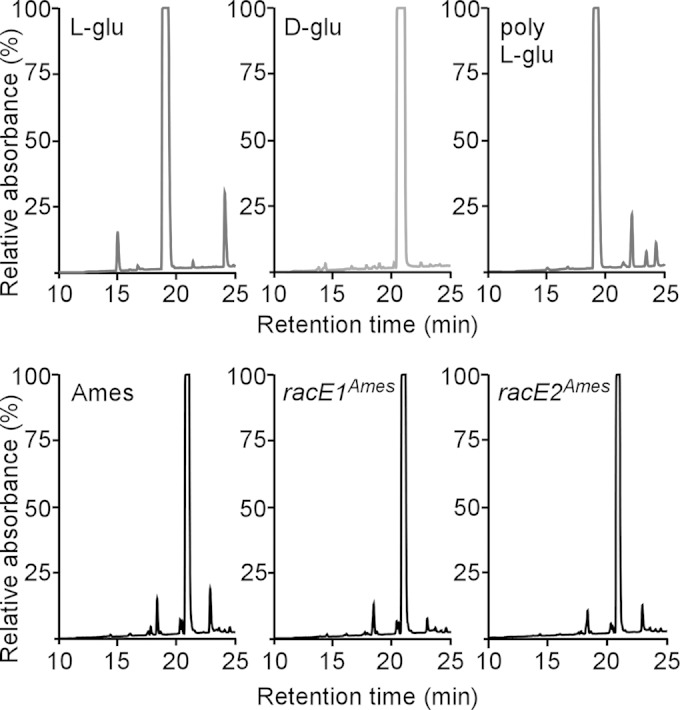
Composition of the polyglutamate capsule in B. anthracis Ames glutamate racemase mutants. Purified capsule polymers from B. anthracis Ames and its racE1Ames or racE2Ames mutants were hydrolyzed in hydrochloric acid, labeled with 1% FDAA, and separated by rpHPLC. l-Glutamic acid, d-glutamic acid, and poly-l-glutamic acid were used as controls.
DISCUSSION
d isomers of two amino acids, alanine and glutamic acid, are key elements of the cell wall of bacteria and essential for the assembly of peptidoglycan (12, 40). Synthesis of d isomers is dependent on racemases, and these enzymes have been studied as potential drug targets with the goal of identifying new antibiotics (3, 41, 42). Alanine racemase requires PLP as a coenzyme, which contributes to catalysis by forming the intermediate d-alanyl-PLP aldimine (43, 44). Cycloserine (4-amino-3-isoxazolidinone), a drug that is approved as a second-line therapeutic against multidrug-resistant M. tuberculosis (45), is an inhibitor of alanine racemase and d-Ala–d-Ala ligase, which contribute to lipid II precursor synthesis (46). Cycloserine has limited efficacy against other bacteria, particularly against microbes that express two different alanine racemase enzymes (47). Cycloserine also has considerable side effects due to the inhibition of PLP-dependent racemases in the human nervous system (45).
Glutamate racemase does not require PLP for catalysis and instead employs cysteine thiolates to deprotonate its l-glutamate substrate and generate the d isomer (48, 49). Considerable sequence variation has been reported for glutamate racemases from different bacteria, which may explain differences in allosteric activation and kinetic regulation of these enzymes (7). Efforts to identify inhibitors of glutamate racemases have thus far been successful for pyrazolopyrimidinediones, which block Helicobacter pylori MurI racemase activity, presumably by binding to a regulatory site of the enzyme (3, 7). Nevertheless, the activity spectrum of these compounds is very narrow and they cannot be used for treatment of infectious diseases caused by drug-resistant bacteria (3). Similar to alanine racemase inhibitors, development of drugs with broad-spectrum activity against glutamate racemase must address the sequence variation of this enzyme family and the potentially confounding effect that several microbes express two different glutamate racemases.
B. anthracis, a Gram-positive, spore-forming firmicute, is the causative agent of anthrax, a zoonotic disease that is rapidly fatal unless treated early with antibiotics (50). Because of the ease with which infectious spores are generated, the agent is disseminated, and drug-resistant strains are isolated, B. anthracis is considered a weapon of mass destruction (51). Glutamate racemase has been identified as a target for the development of antibiotics that can combat drug-resistant B. anthracis (4). This concept was supported by findings of Shatalin and Neyfakh, who reported that each of the two glutamate racemase genes of B. anthracis, racE1 and racE2, is essential for vegetative growth (28). Here we demonstrate that this model is not correct. Each gene, racE1 or racE2, can be deleted from the chromosome of B. anthracis Sterne, a noncapsulating vaccine strain lacking the pXO2 virulence plasmid, and from B. anthracis Ames, a fully virulent, capsulating isolate. We do not know the reasons for the discrepancy between the findings of the two studies because Shatalin and Neyfakh did not include data on racE1 and racE2 mutants in their publication on a plasmid system for allelic replacement (28). It seems unlikely that these differences are caused by strain differences; Shatalin and Neyfakh used B. anthracis ΔANR, a plasmidless variant of B. anthracis Ames (pXO1 pXO2), which was examined in our study.
Unlike racE1 mutants, B. anthracis lacking racE2 displays delayed growth and even cell death following germination. racE2 mutant cells had a round or oval shape, similar to the spore outgrowth phenotype of B. subtilis pbpA mutants, which cannot adequately support cell wall elongation because of loss of transpeptidase activity but are not defective in the formation of septal peptidoglycan (52, 53). racE2 mutant cells that did survive eventually replicated with kinetics similar to those of wild-type B. anthracis. Taken together, these data suggest that RacE2 is a key enzyme for newly germinated spores, supplying d-glutamate for peptidoglycan synthesis. These observations are in agreement with gene expression studies showing that racE2 is preferentially expressed during early vegetative growth (54). At a later stage of vegetative growth, both RacE1 and RacE2 are independently capable of providing B. anthracis with d-glutamate for peptidoglycan and PDGA capsule synthesis. Of note, B. anthracis mutants lacking racE1 and racE2 appear nonviable, suggesting that d-amino-acid transaminases are not sufficient to provide anthrax bacilli with d-glutamate, as has been reported for B. subtilis (17).
Homology modeling of RacE1 and RacE2 revealed potential differences within the active-site pocket that might affect the design of inhibitory pharmacophores (55). Earlier work discovered a natural product, dipicolinic acid, that acts as an allosteric inhibitor of B. anthracis RacE1 and RacE2 (55). The dipicolinic acid binding pocket is distinct from that of pyrazolopyrimidinedione on H. pylori MurI (55). Dipicolinic acid occurs at high concentrations in the B. anthracis spore and has been implicated as a key factor in the regulation of this organism's life cycle (56). The inhibitory attributes of dipicolinic acid for glutamate racemases may explain the requirement of racE2 for vegetative growth of B. anthracis immediately following the germination of spores.
ACKNOWLEDGMENTS
We thank laboratory members for experimental advice and discussion.
This work was supported by a grant from the National Institute of Allergy and Infectious Diseases, Infectious Diseases Branch (AI069227).
REFERENCES
- 1.Lugtenberg EJ, Wijsman HJ, van Zaane D. 1973. Properties of a d-glutamic acid-requiring mutant of Escherichia coli. J Bacteriol 114:499–506. [DOI] [PMC free article] [PubMed] [Google Scholar]
- 2.Lovering AL, Safadi SS, Strynadka NC. 2012. Structural perspective of peptidoglycan biosynthesis and assembly. Annu Rev Biochem 81:451–478. doi: 10.1146/annurev-biochem-061809-112742. [DOI] [PubMed] [Google Scholar]
- 3.de Jonge BL, Kutschke A, Uria-Nickelsen M, Kamp HD, Mills SD. 2009. Pyrazolopyrimidinediones are selective agents for Helicobacter pylori that suppress growth through inhibition of glutamate racemase (MurI). Antimicrob Agents Chemother 53:3331–3336. doi: 10.1128/AAC.00226-09. [DOI] [PMC free article] [PubMed] [Google Scholar]
- 4.May M, Mehboob S, Mulhearn DC, Wang Z, Yu H, Thatcher GR, Santarsiero BD, Johnson ME, Mesecar AD. 2007. Structural and functional analysis of two glutamate racemase isozymes from Bacillus anthracis and implications for inhibitor design. J Mol Biol 371:1219–1237. doi: 10.1016/j.jmb.2007.05.093. [DOI] [PMC free article] [PubMed] [Google Scholar]
- 5.Manning JM, Merrifield NE, Jones WM, Gotschlich EC. 1974. Inhibition of bacterial growth by beta-chloro-d-alanine. Proc Natl Acad Sci U S A 71:417–421. doi: 10.1073/pnas.71.2.417. [DOI] [PMC free article] [PubMed] [Google Scholar]
- 6.Geng B, Breault G, Comita-Prevoir J, Petrichko R, Eyermann C, Lundqvist T, Doig P, Gorseth E, Noonan B. 2008. Exploring 9-benzyl purines as inhibitors of glutamate racemase (MurI) in Gram-positive bacteria. Bioorg Med Chem Lett 18:4368–4372. doi: 10.1016/j.bmcl.2008.06.068. [DOI] [PubMed] [Google Scholar]
- 7.Lundqvist T, Fisher SL, Kern G, Folmer RH, Xue Y, Newton DT, Keating TA, Alm RA, de Jonge BL. 2007. Exploitation of structural and regulatory diversity in glutamate racemases. Nature 447:817–822. doi: 10.1038/nature05689. [DOI] [PubMed] [Google Scholar]
- 8.Choi SY, Esaki N, Yoshimura T, Soda K. 1992. Reaction mechanism of glutamate racemase, a pyridoxal phosphate-independent amino acid racemase. J Biochem 112:139–142. [DOI] [PubMed] [Google Scholar]
- 9.Martínez del Pozo A, Merola M, Ueno H, Manning J M, Tanizawa K, Nishimura K, Soda K, Ringe D. 1989. Stereospecificity of reactions catalyzed by bacterial d-amino acid transaminase. J Biol Chem 264:17784–17789. [PubMed] [Google Scholar]
- 10.Sugio S, Petsko GA, Manning JM, Soda K, Ringe D. 1995. Crystal structure of a d-amino acid aminotransferase: how the protein controls stereoselectivity. Biochemistry 34:9661–9669. doi: 10.1021/bi00030a002. [DOI] [PubMed] [Google Scholar]
- 11.Yonaha K, Misono H, Yamamoto T, Soda K. 1975. d-Amino acid aminotransferase of Bacillus sphaericus. Enzymologic and spectrometric properties. J Biol Chem 250:6983–6989. [PubMed] [Google Scholar]
- 12.Doublet PJ, van Heijenoort Bohin JP, Mengin-Lecreulx D. 1993. The murI gene of Escherichia coli is an essential gene that encodes a glutamate racemase activity. J Bacteriol 175:2970–2979. [DOI] [PMC free article] [PubMed] [Google Scholar]
- 13.Morayya S, Awasthy D, Yadav R, Ambady A, Sharma U. 2015. Revisiting the essentiality of glutamate racemase in Mycobacterium tuberculosis. Gene 555:269–276. doi: 10.1016/j.gene.2014.11.017. [DOI] [PubMed] [Google Scholar]
- 14.Fotheringham IG, Bledig SA, Taylor PP. 1998. Characterization of the genes encoding d-amino acid transaminase and glutamate racemase, two d-glutamate biosynthetic enzymes of Bacillus sphaericus ATCC 10208. J Bacteriol 180:4319–4323. [DOI] [PMC free article] [PubMed] [Google Scholar]
- 15.Pucci MJ, Thanassi JA, Ho HT, Falk PJ, Dougherty TJ. 1995. Staphylococcus haemolyticus contains two d-glutamic acid biosynthetic activities, a glutamate racemase and a d-amino acid transaminase. J Bacteriol 177:336–342. [DOI] [PMC free article] [PubMed] [Google Scholar]
- 16.Ashiuchi M, Shimanouchi K, Nakamura H, Kamei T, Soda K, Park C, Sung MH, Misono H. 2004. Enzymatic synthesis of high-molecular-mass poly-gamma-glutamate and regulation of its stereochemistry. Appl Environ Microbiol 70:4249–4255. doi: 10.1128/AEM.70.7.4249-4255.2004. [DOI] [PMC free article] [PubMed] [Google Scholar]
- 17.Kimura K, Tran LS, Itoh Y. 2004. Roles and regulation of the glutamate racemase isogenes, racE and yrpC, in Bacillus subtilis. Microbiology 150:2911–2920. doi: 10.1099/mic.0.27045-0. [DOI] [PubMed] [Google Scholar]
- 18.Ashiuchi M, Tani K, Soda K, Misono H. 1998. Properties of glutamate racemase from Bacillus subtilis IFO 3336 producing poly-gamma-glutamate. J Biochem 123:1156–1163. doi: 10.1093/oxfordjournals.jbchem.a022055. [DOI] [PubMed] [Google Scholar]
- 19.Ashiuchi M, Kuwana E, Komatsu K, Soda K, Misono H. 2003. Differences in effects on DNA gyrase activity between two glutamate racemases of Bacillus subtilis, the poly-gamma-glutamate synthesis-linking Glr enzyme and the YrpC (MurI) isozyme. FEMS Microbiol Lett 223:221–225. doi: 10.1016/S0378-1097(03)00381-1. [DOI] [PubMed] [Google Scholar]
- 20.Kobayashi K, Ehrlich SD, Albertini A, Amati G, Andersen KK, Arnaud M, Asai K, Ashikaga S, Aymerich S, Bessieres P, Boland F, Brignell SC, Bron S, Bunai K, Chapuis J, Christiansen LC, Danchin A, Debarbouille M, Dervyn E, Deuerling E, Devine K, Devine SK, Dreesen O, Errington J, Fillinger S, Foster SJ, Fujita Y, Galizzi A, Gardan R, Eschevins C, Fukushima T, Haga K, Harwood CR, Hecker M, Hosoya D, Hullo MF, Kakeshita H, Karamata D, Kasahara Y, Kawamura F, Koga K, Koski P, Kuwana R, Imamura D, Ishimaru M, Ishikawa S, Ishio I, Le Coq D, Masson A, Mauel C, et al. 2003. Essential Bacillus subtilis genes. Proc Natl Acad Sci U S A 100:4678–4683. doi: 10.1073/pnas.0730515100. [DOI] [PMC free article] [PubMed] [Google Scholar]
- 21.Tanizawa K, Masu Y, Asano S, Tanaka H, Soda K. 1989. Thermostable d-amino acid aminotransferase from a thermophilic Bacillus species. Purification, characterization, and active site sequence determination. J Biol Chem 264:2445–2449. [PubMed] [Google Scholar]
- 22.Bruckner V, Kovacs J, Denes G. 1953. Structure of poly-d-glutamic acid isolated from capsulated strains of B. anthracis. Nature 172:508. doi: 10.1038/172508a0. [DOI] [PubMed] [Google Scholar]
- 23.Hanby WE, Rydon HN. 1946. The capsular substance of Bacillus anthracis. Biochem J 40:297–309. [PubMed] [Google Scholar]
- 24.Candela T, Mock M, Fouet A. 2005. CapE, a 47-amino-acid peptide, is necessary for Bacillus anthracis polyglutamate capsule synthesis. J Bacteriol 187:7765–7772. doi: 10.1128/JB.187.22.7765-7772.2005. [DOI] [PMC free article] [PubMed] [Google Scholar]
- 25.Drysdale M, Heninger S, Hutt J, Chen Y, Lyons CR, Koehler TM. 2005. Capsule synthesis by Bacillus anthracis is required for dissemination in murine inhalation anthrax. EMBO J 24:221–227. doi: 10.1038/sj.emboj.7600495. [DOI] [PMC free article] [PubMed] [Google Scholar]
- 26.Richter GS, Anderson VJ, Garufi G, Lu L, Joachimiak A, He C, Schneewind O, Missiakas D. 2009. Capsule anchoring in Bacillus anthracis occurs by a transpeptidation mechanism that is inhibited by capsidin. Mol Microbiol 71:404–420. doi: 10.1111/j.1365-2958.2008.06533.x. [DOI] [PMC free article] [PubMed] [Google Scholar]
- 27.Barnard JP, Friedlander AM. 1999. Vaccination against anthrax with attenuated recombinant strains of Bacillus anthracis that produce protective antigen. Infect Immun 67:562–567. [DOI] [PMC free article] [PubMed] [Google Scholar]
- 28.Shatalin KY, Neyfakh AA. 2005. Efficient gene inactivation in Bacillus anthracis. FEMS Microbiol Lett 245:315–319. doi: 10.1016/j.femsle.2005.03.029. [DOI] [PubMed] [Google Scholar]
- 29.Dodd D, Reese JG, Louer CR, Ballard JD, Spies MA, Blanke SR. 2007. Functional comparison of the two Bacillus anthracis glutamate racemases. J Bacteriol 189:5265–5275. doi: 10.1128/JB.00352-07. [DOI] [PMC free article] [PubMed] [Google Scholar]
- 30.Kim HU, Goepfert JM. 1974. A sporulation medium for Bacillus anthracis. J Appl Bacteriol 37:265–267. doi: 10.1111/j.1365-2672.1974.tb00438.x. [DOI] [PubMed] [Google Scholar]
- 31.Garufi G, Wang Y-T, Oh S-Y, Maier H, Missiakas DM, Schneewind O. 2012. Sortase-conjugation generates a capsule vaccine that protects guinea pigs against Bacillus anthracis. Vaccine 30:3435–3444. doi: 10.1016/j.vaccine.2012.03.023. [DOI] [PMC free article] [PubMed] [Google Scholar]
- 32.Marraffini LA, Schneewind O. 2006. Targeting proteins to the cell wall of sporulating Bacillus anthracis. Mol Microbiol 62:1402–1417. doi: 10.1111/j.1365-2958.2006.05469.x. [DOI] [PubMed] [Google Scholar]
- 33.Oh SY, Budzik JM, Garufi G, Schneewind O. 2011. Two capsular polysaccharides enable Bacillus cereus G9241 to cause anthrax-like disease. Mol Microbiol 80:455–470. doi: 10.1111/j.1365-2958.2011.07582.x. [DOI] [PMC free article] [PubMed] [Google Scholar]
- 34.Green BD, Battisti L, Koehler TM, Thorne CB, Ivins BE. 1985. Demonstration of a capsule plasmid in Bacillus anthracis. Infect Immun 49:291–297. [DOI] [PMC free article] [PubMed] [Google Scholar]
- 35.Ruhfel RE, Robillard NJ, Thorne CB. 1984. Interspecies transduction of plasmids among Bacillus anthracis, B. cereus, and B. thuringiensis. J Bacteriol 157:708–711. [DOI] [PMC free article] [PubMed] [Google Scholar]
- 36.Bubeck Wardenburg J, Williams WA, Missiakas D. 2006. Host defenses against Staphylococcus aureus infection require recognition of bacterial lipoproteins. Proc Natl Acad Sci U S A 103:13831–13836. doi: 10.1073/pnas.0603072103. [DOI] [PMC free article] [PubMed] [Google Scholar]
- 37.Tam C, Glass EM, Anderson DM, Missiakas D. 2006. Transposon mutagenesis of Bacillus anthracis strain Sterne using bursa aurealis. Plasmid 56:74–77. doi: 10.1016/j.plasmid.2006.01.002. [DOI] [PubMed] [Google Scholar]
- 38.Kern JW, Schneewind O. 2008. BslA, a pXO1-encoded adhesin of Bacillus anthracis. Mol Microbiol 68:504–515. doi: 10.1111/j.1365-2958.2008.06169.x. [DOI] [PubMed] [Google Scholar]
- 39.Read TD, Salzberg SL, Pop M, Shumway M, Umayam L, Jiang L, Holtzapple E, Busch JD, Smith KL, Schupp JM, Solomon D, Keim P, Fraser CM. 2002. Comparative genome sequencing for discovery of novel polymorphisms in Bacillus anthracis. Science 296:2028–2033. doi: 10.1126/science.1071837. [DOI] [PubMed] [Google Scholar]
- 40.Lazdunski C, Shaprio BM. 1972. Relationship between permeability, cell division, and murein metabolism in a mutant of Escherichia coli. J Bacteriol 111:499–509. [DOI] [PMC free article] [PubMed] [Google Scholar]
- 41.Faraci WS, Walsh CT. 1989. Mechanism of inactivation of alanine racemase by beta, beta, beta-trifluoroalanine. Biochemistry 28:431–437. doi: 10.1021/bi00428a004. [DOI] [PubMed] [Google Scholar]
- 42.Whalen KL, Pankow KL, Blanke SR, Spies MA. 2010. Exploiting enzyme plasticity in virtual screening: high efficiency inhibitors of glutamate racemase. ACS Med Chem Lett 1:9–13. doi: 10.1021/ml900005b. [DOI] [PMC free article] [PubMed] [Google Scholar]
- 43.Neidhart DJ, Distefano MD, Tanizawa K, Soda K, Walsh CT, Petsko GA. 1987. X-ray crystallographic studies of the alanine-specific racemase from Bacillus stearothermophilus. Overproduction, crystallization, and preliminary characterization. J Biol Chem 262:15323–15326. [PubMed] [Google Scholar]
- 44.Copié V, Faraci WS, Walsh CT, Griffin RG. 1988. Inhibition of alanine racemase by alanine phosphonate: detection of an imine linkage to pyridoxal 5′-phosphate in the enzyme-inhibitor complex by solid-state 15N nuclear magnetic resonance. Biochemistry 27:4966–4970. doi: 10.1021/bi00414a002. [DOI] [PubMed] [Google Scholar]
- 45.Protivinsky R. 1971. Cycloserine. Antibiot Chemother 17:87–94. [DOI] [PubMed] [Google Scholar]
- 46.Strominger JL, Ito E, Threnn RH. 1960. Competitive inhibition of enzymatic reactions by oxamycin. J Am Chem Soc 82:998–999. doi: 10.1021/ja01489a058. [DOI] [Google Scholar]
- 47.Wasserman SA, Walsh CT, Botstein D. 1983. Two alanine racemase genes in Salmonella typhimurium that differ in structure and function. J Bacteriol 153:1439–1450. [DOI] [PMC free article] [PubMed] [Google Scholar]
- 48.Gallo KA, Tanner ME, Knowles JR. 1993. Mechanism of the reaction catalyzed by glutamate racemase. Biochemistry 32:3991–3997. doi: 10.1021/bi00066a020. [DOI] [PubMed] [Google Scholar]
- 49.Glavas S, Tanner ME. 2001. Active site residues of glutamate racemase. Biochemistry 40:6199–6204. doi: 10.1021/bi002703z. [DOI] [PubMed] [Google Scholar]
- 50.Mock M, Fouet A. 2001. Anthrax. Annu Rev Microbiol 55:647–671. doi: 10.1146/annurev.micro.55.1.647. [DOI] [PubMed] [Google Scholar]
- 51.Inglesby TV, Henderson DA, Bartlett JG, Ascher MS, Eitzen E, Jahrling PB, Hauer J, Layton M, McDade J, Osterholm MT, O'Toole T, Parker G, Perl T, Russel PK, Tonat K. 1999. Anthrax as a biological weapon: medical and public health management. Working group on civilian biodefense. JAMA 281:1735–1745. [DOI] [PubMed] [Google Scholar]
- 52.Murray T, Popham DL, Setlow P. 1997. Identification and characterization of pbpA encoding Bacillus subtilis penicillin-binding protein 2A. J Bacteriol 179:3021–3029. [DOI] [PMC free article] [PubMed] [Google Scholar]
- 53.Murray T, Popham DL, Pearson CB, Hand AR, Setlow P. 1998. Analysis of outgrowth of Bacillus subtilis spores lacking penicillin-binding protein 2A. J Bacteriol 180:6493–6502. [DOI] [PMC free article] [PubMed] [Google Scholar]
- 54.Passalacqua KD, Varadarajan A, Ondov BD, Okou DT, Zwick ME, Bergman NH. 2009. Structure and complexity of a bacterial transcriptome. J Bacteriol 191:3203–3211. doi: 10.1128/JB.00122-09. [DOI] [PMC free article] [PubMed] [Google Scholar]
- 55.Whalen KL, Tussey KB, Blanke SR, Spies MA. 2011. Nature of allosteric inhibition in glutamate racemase: discovery and characterization of a cryptic inhibitory pocket using atomistic MD simulations and pKa calculations. J Phys Chem B 115:3416–3424. doi: 10.1021/jp201037t. [DOI] [PMC free article] [PubMed] [Google Scholar]
- 56.Setlow P. 2014. Germination of spores of Bacillus species: what we know and do not know. J Bacteriol 196:1297–1305. doi: 10.1128/JB.01455-13. [DOI] [PMC free article] [PubMed] [Google Scholar]



